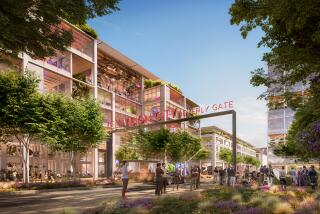Future Stock : Fillmore Encourages Population Increase, Aims to Cash In on Small-Town Charm
- Share via
Four months ago, Richard Bellenbaum, an inspector for the Department of Defense, was transferred from Whittier to a job in Van Nuys.
Searching for a new home, Bellenbaum and his wife, Marisela, looked everywhere from Northridge to Palmdale to Simi Valley.
But it wasn’t until they came to Fillmore that the Los Angeles County natives made up their minds.
They saw no graffiti. They were charmed by quiet tree-lined streets and pleasantly shocked when a stranger took them for burglars and threatened to call the police while they were peering into an empty house that was posted with a for-sale sign.
The Bellenbaums, with two toddlers and a 40-mile commute from Fillmore to ITT Gilfillan in Van Nuys, decided to make Fillmore their home.
The Bellenbaums exemplify this struggling town’s dream to rebuild itself.
Over the next decade, Fillmore wants to attract many more such families as it deals with the death of the oil industry and a shifting agricultural base, officials said.
It’s banking on new middle-class residents who will own property and pay taxes, ensuring that Fillmore, whose youngsters have left looking for better jobs, does not become a ghost town.
Two years ago, Fillmore did not welcome development. Now, one builder says, it stands with open arms to carefully planned mid-priced residential development.
But as Fillmore moves toward change, it finds itself at a crossroads, wanting to preserve its gentle, small-town atmosphere while developing both residentially and commercially.
It may not be easy. Already, struggling downtown merchants are unhappy about the specter of a commercial center to be built less than a mile from their shops.
A century ago, Fillmore grew up around the railroad. Trains would steam into town to transport passengers to nearby cities and to haul oranges and avocados from local orchards.
But as cars replaced public transportation and trucks began hauling produce, the trains stopped running. In the 1950s, the Texaco oil refinery shut down, and in 1974, Southern Pacific Railroad, which had operated in Fillmore since the 1800s, sold its office to the local museum.
By the early 1980s, the city had entered a declining economic period. Businesses left town, agriculture became more mechanized, and Fillmore’s younger generations fled because of a lack of jobs, said Dorothy Haase, the director of the Fillmore Historical Museum.
The economic situation worsened last year after the community of nearly 13,000 suffered an estimated $50 million worth of damage during the Northridge quake.
Today, Fillmore wants to turn its earthquake-damaged downtown into a tourist destination offering a variety of shops and restaurants, and trains that travel to orange groves.
*
And with the second-lowest per capita income in the county, Fillmore also wants to attract middle-class families so it can expand its revenue sources.
“We need to improve the average income in the city--otherwise we can’t grow,” said city Councilman Don Gunderson. “We need to increase the city’s sales and property taxes, and to do that we need to bring in more people. People who will spend money here.”
Although Fillmore spurned development as recently as two years ago, it now welcomes it, said builder Jack Sorenson, who owns Inter-Cal Development Inc.
Sorenson has wanted to build 63 houses on a 15-acre site near the Santa Clara River since 1989, but it wasn’t until last year that he obtained clearance from the city to go ahead with the project, he said.
“City Hall [now] has a very positive and open attitude about development,” said Sorenson, who has operated out of Fillmore since 1970. “They actually try to assist and help the developer. But it was not always as harmonious. Things were difficult before.”
City Manager Roy Payne acknowledged that the city has changed its residential development policies.
“We did have some problems with our staff, but . . . we have been working very hard to streamline our permitting procedures,” Payne said. “We want to eliminate as much of the delays as possible.”
Inspired by Fillmore’s new attitude toward development, Sorenson said he is working on a project to build 500 homes in a 160-acre parcel along the Santa Clara River within the next five years.
Although Fillmore’s new houses are not expensive by county standards, nor are they being built for low-income families. The average yearly income per household in Fillmore is $33,482, but the houses being built cost $145,000 to $180,000.
And the city has no plans to build low-income apartment buildings.
“We want to attract people who have a higher income than we do,” said City Councilman Scott Lee. “But we also want people from Fillmore to buy homes here. It may be economically difficult, but the city has several programs to assist first-time buyers.”
*
Fillmore’s effort to turn its declining downtown into a 1920s-era tourist center began in 1991 when the city paid $1.7 million for the old Southern Pacific train station in a 13-acre parcel downtown.
In addition, the city loaned $50,000 to a Los Angeles County company, Short Line Enterprises, to help run train excursions from Fillmore to orange groves in the heart of the Santa Clara Valley.
The company has been offering the excursions nearly every other weekend since March, and the train attracts 800 to 1,400 riders a day, said Short Line spokesman Larry Jensen.
The city’s goal now is to make its downtown attractive so those tourists will want to stick around and spend their dollars in local shops.
“We have a wonderful opportunity to help Fillmore grow,” said City Councilman Roger Campbell. “This town has been flocking with tourists, and we need to take advantage of that. We need to cater to that industry.”
The city is paying $40,000 to a Sacramento-based consultant to conduct a marketing study that will delineate what sort of businesses will better serve tourists, Payne said.
After conducting the study, the consulting firm will meet with each of the 36 downtown merchants to advise them on how they can change, expand and improve.
“I have no doubts that it will be difficult for some merchants to change, but I don’t think they have a choice,” Campbell said.
Payne agreed.
“If we don’t do anything, the town will die,” he said. “Based upon our location and history, tourism is a good industry for us.”
Some businesses that might be geared toward tourists are coffeehouses, restaurants, antique stores and art and craft shops, Campbell said.
The city has earmarked nearly $2 million to award in grants of $10,000 to $45,000 to merchants so they can pay for improvements on the facades of their buildings. Part of that money will be used to renovate the city’s only movie theater, which was nearly destroyed during the earthquake.
Moreover, the city is building a square in the heart of its business community.
To be erected in the city’s Central Park, the town-square project will feature a 15,000-square-foot City Hall, a brick plaza with a cast-iron fountain and walks that fan out from the fountain to the corners.
*
Construction of the town square is scheduled to begin Wednesday, said City Planner Anthony Perez.
But the same city officials who want to pump up downtown recently approved the construction of a potent competitor--an 80,000-square-foot shopping center on California 126, less than a mile from the struggling downtown.
The new shopping center, to be called Balden Towne Plaza, will be home to a 41,000-square-foot Vons grocery store. Vons now operates out of a 14,000-square-foot building nearby.
City officials said they want the shopping center to lure businesses that can provide services not offered in Fillmore, including a shoe store, mail box rentals and a picture framing store.
Fillmore realtor Bill Garbanatti said that one of the first things newcomers want to know is what shops the city offers.
“People often ask me why we don’t have a better grocery store or a shoe store or a bakery,” Garbanatti said. “I know a lot of people in Fillmore who do their shopping in Simi Valley and Ventura.”
But merchants downtown are skeptical about Balden Towne Plaza.
“There is no way that they’ll build that shopping center because there is no business to support it,” said Mike Garner, co-owner of Fillmore Plumbing.
Fillmore native Shirley Wright said that if the shopping center is built, it will badly damage stores like hers.
“It will pull business from our downtown. I have no doubts about that. It will be a question of time before we have to close,” said Wright, who has operated her dress shop for five years. “And it will definitely change the quaintness of Fillmore. Malls are malls. They are the same everywhere.”
But city officials say the shopping center will serve not only Fillmore’s hoped-for new wave of more prosperous residents, but also motorists in increasing numbers along an expanded Highway 126.
*
Caltrans plans to widen the highway to four lanes from Fillmore to I-5 in Santa Clarita within the next five years, and Fillmore leaders hope that residents from the San Fernando Valley and Santa Clarita, who now travel on Highway 101 to reach Ventura County beaches, will instead use the 126.
“I don’t think that the small mom-and-pop shops will be affected by the shopping center,” Fillmore Mayor Linda Brewster said. “People in the community have a lot of loyalty to the local merchants. Besides, you can’t run up a tab at Vons, but you can in one of our small grocery stores.”
As Fillmore eagerly seeks to bolster its population to more than 18,000 tax-paying residents by 2010, the most difficult question it faces is how to keep its cherished small-town atmosphere.
“Hopefully people who move to Fillmore will know what they are getting into: a small town where you can walk at night, where people don’t lock their doors and which offers the peace and beauty of a green valley,” Brewster said. “If they understand that, Fillmore will not change.”
But already there are signs of cultural division.
City Councilman Campbell said he has already noticed a change in the behavior of newcomers who live in the newest part of town.
“Fillmore is the type of community where you either know everyone, or at least you recognize their faces, their names,” said Campbell, who has lived all his life in Fillmore. “But we are losing some of that already. We need to find ways to integrate them [newcomers] into the small-town community that Fillmore is.”
(BEGIN TEXT OF INFOBOX / INFOGRAPHIC)
Small Town With Big Plans
Fillmore is trying to improve its economy while maintaining its small-town atmosphere. In an attempt to increase its revenues, the city hopes to turn its earthquake-damaged downtown into a tourist destination and to attract more middle-class residents.
Population of Fillmore: 12,872
Latino: 59.3%
White: 39.4%
Other: 1.3%
Demographic Comparison
Fillmore Ventura County Average Household Size 3.6 people 3.1 people Average Household Income $33,482 $45,612 Average Housing Price $189,700 $245,300 Per Capita Income $10,674 $17,861 EDUCATION High School Diploma or higher 56.8% 79.4% Bachelor’s Degree 8.6% 23%
Source: 1990 U.S. Census and State Department of Finance
More to Read
Inside the business of entertainment
The Wide Shot brings you news, analysis and insights on everything from streaming wars to production — and what it all means for the future.
You may occasionally receive promotional content from the Los Angeles Times.










